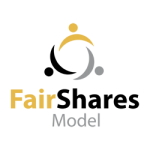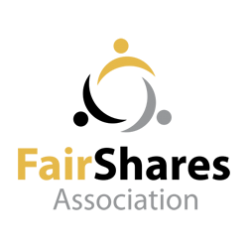Introduction
The FairShares Model is a brand and concept created by The FairShares Association between 2013 and 2020 to assist the creation of FairShares Enterprises. At the heart of the brand is a definition of social enterprise established by Social Enterprise International Ltd that advances five principles.
Five Principles
Download a PDF – V3.0-01-FiveValuesandPrinciples (Final)
For use by associations, companies, co-operative societies, partnerships, consultancies and educators to communicate:
 wealth and power sharing among primary stakeholders – The FairShares Model structures a company, co-operative, association or partnership in such a way that the wealth created is shared fairly amongst founders, producers, users and investors. It does this in several ways – through membership rights, through issuing shares (in companies and co-operatives) and through creating funds that directors, workers and users can each decide how should be spent. This inclusive approach encourages participatory management and governance that spreads decision-making to all primary stakeholders and gives them a voice in the decisions that affect the future of their joint enterprise.
wealth and power sharing among primary stakeholders – The FairShares Model structures a company, co-operative, association or partnership in such a way that the wealth created is shared fairly amongst founders, producers, users and investors. It does this in several ways – through membership rights, through issuing shares (in companies and co-operatives) and through creating funds that directors, workers and users can each decide how should be spent. This inclusive approach encourages participatory management and governance that spreads decision-making to all primary stakeholders and gives them a voice in the decisions that affect the future of their joint enterprise.- specification of social purpose(s) and auditing of social impact(s) – The members of a FairShares enterprise are empowered by the constitution to establish social goals (such as specific improvements to their own, their community’s and the wider environment’s health and well-being). The achievement of these goals can be reviewed through social auditing (provided for within model FairShares constitutions). Social auditing is a process for checking with stakeholders whether the economic, social and environmental outcomes desired are being achieved and for deciding what to do if they are not.
- ethical review of the choice of goods/services offered – The managers and members of a FairShares enterprise are encouraged to think carefully about the well-being that their joint enterprise creates (or could create) through designing and offering products and services. In short, there is a commitment to creating goods/services that are good for people, society and the environment (a triple-bottom line outcome). If it is not possible to create products and services that improve well-being, then it should trigger debate on whether to stop production.
- ethical review of production and retailing processes – The managers and users of a FairShares enterprise’s products and services are encouraged to consider how the process of production and retailing affects members, society and the environment. In short, there is a commitment to producing and retailing the goods/services in a way that enhances the well-being of the stakeholders who produce and consume them. If it is not possible to produce or consume in a way that advances well-being and/or reduces environmental impact, then debates should take place on whether to stop production or adopt alternative production / consumption practices.
- a social democratic model for the ownership, governance and management of capital – A FairShares enterprise seeks to extend ownership to all primary stakeholders directly affected by its operations (founders, producers, users and investors) so that they have a clear right to participate in decisions on how capital is managed. ‘Capital’ within a FairShares enterprise is understood to include natural capital (resources provided by nature – e.g. air, water and minerals), manufactured capital (machinery and premises), social capital (networks of people), human capital (workers’ energy, skills and abilities), intellectual capital (workers’ ideas and designs) and financial capital (contributions of money). The goal of the model is to compensate the providers of each type of capital fairly and equitably.
Levels of Alignment
We defined three levels of alignment to assess progress towards the application of FairShares Model values and principles:
- Level 1 – an enterprise actively disseminates the FairShares Model externally, but there is little evidence that the five values and principles are applied internally.
- Level 2 – an enterprise publicly supports the use of the FairShares Model and implements the five values and principles internally using proprietory / bespoke design principles.
- Level 3 – an enterprise publicly supports the use of the FairShares Model and puts them into practice by adopting (and adapting) FairShares IP.
